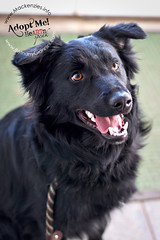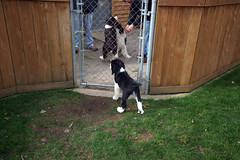Vomiting in dogs is a very common occurrence and can arise from a wide variety of causes, from simple gastritis to complex diseases of other body systems. Not only is it very distressing for both the dog and owner, it also provides a challenge for the veterinarian. This article explains the multiple causes of vomiting in dogs, including adverse food reactions, and the range of treatment options available.
What is vomiting?
Dog
Vomiting is the expulsion of food, fluid or debris from the stomach or small intestine due to coordinated movements of the gastrointestinal, musculoskeletal and nervous systems. It is important to differentiate this from regurgitation, which is a passive process rather than a coordinated effort like vomiting.
Help, My Dog is Vomiting
Regurgitation is a sign of disease in the esophagus, such as obstructions (foreign bodies such as a stick, bone or toy, or a stricture), esophagitis (inflammation of the esophagus) or megaesophagus (dilatation of the esophagus due to weakening of the smooth muscle). The main difference between regurgitation and vomiting is that regurgitation is effortless, while vomiting is accompanied by strong abdominal contractions.
How can I tell vomiting and regurgitation apart?
Sometimes this is not easy to do. Generally speaking, if it happens immediately after eating it is more likely to be regurgitation (though vomiting can still occur then). If the content of the material expelled appears to be completely undigested food, this also supports regurgitation. If the presence of bile can be confirmed though, it is more likely to be vomiting.
Causes of vomiting
The most common causes of vomiting are dietary related, either through dietary indiscretion (e.g. overeating, eating overly rich or spoiled food) which causes acute (sudden) vomiting, or adverse food reactions (food allergies) which can cause chronic (long term and intermittent) vomiting.
However, there are a huge number of other causes arising from either the gastrointestinal system itself (stomach and small intestine) or secondary to disease elsewhere in the body (e.g. liver or kidney disease). Within the stomach, possible causes include:
1. Gastritis (inflammatory disease)
2. Stomach ulceration
3. Stomach cancer
4. Obstruction (foreign bodies, telescoping of intestine)
5. Hiatal hernia (part stomach herniating through the diaphragm)
Possible causes within the intestine include:
1. Infectious diseases (e.g. parvovirus)
2. Worms
3. Inflammatory bowel disease
4. Intestinal cancer
Secondary causes of vomiting that are due to disease elsewhere in the body include:
1. Pancreatitis (infection or inflammation of the pancreas)
2. Peritonitis (infection in the abdominal cavity)
3. Hepatitis (liver inflammation)
4. Kidney failure
5. Pyometra (infection of the uterus)
6. Hormonal deficiencies or excesses (e.g. Addisons disease, Diabetes Mellitus, Septicemia, Calcium imbalance)
Other potential causes that do not fit into the above categories are drug reactions (e.g. digoxin, chemotherapy drugs, NSAIDs) and neurological disorders.
Treatment of vomiting
Vomiting is a symptom, not a disease in itself. Whether or not treatment is appropriate depends upon the individual circumstances. If the dog is only vomiting occasionally, is bright and otherwise normal on examination, treatment is probably not necessary. Some dogs with sensitive digestive systems will vomit once or twice a month regardless of any treatment, and if they are otherwise well this should be ignored.
For acute vomiting cases, the first step should always be to starve the dog for 24 hours (while keeping plenty of water available ad lib). After the period of starvation, the dog should be offered small portions of a very bland food, such as chicken and boiled rice, for a few days. Meals should be fed as smaller portions several times a day, rather than one larger meal.
Though treating the symptom itself will often improve patient demeanor and comfort, it is no replacement for making a correct diagnosis of the underlying cause, and certain drugs can be harmful if given blindly (for example, giving metoclopromide to a dog with a gastric or intestinal obstruction). Certainly cases of acute and severe vomiting require immediate treatment, as dogs can become rapidly dehydrated, develop electrolyte imbalances and aspiration pneumonia otherwise.
Managing the vomiting dog
There are 2 goals when dealing with a vomiting dog:
1. Identify the underlying cause
2. Stop the vomiting in a safe and effective manner
In many cases, anti emetic therapy (the technical term for vomiting is emesis, and therefore drugs used to treat it are called anti emetics) is instigated immediately while the cause is being established.
A veterinarian will start by taking a full history, focusing especially on normal diet, recent medication, vaccination status and the description of the symptoms. He or she must first make sure that the dog is genuinely vomiting and not regurgitating, which has a completely different set of underlying causes. It is also important to get a graphic description of the material expelled, and whether it contained bile, fresh blood or what appears to be coffee granules (partly digested blood).
The next step is a full clinical examination, including carefully feeling the abdomen, taking the dogs rectal temperature and assessing the hydration status. Once this is completed, a veterinarian will have a slightly narrowed down list of differential diagnoses in mind. If the dog is not dehydrated, bright in demeanor, and both vital parameters and feeling the abdomen were normal, the veterinarian will often (and rightly so) make a presumptive diagnosis of gastritis, or gastroenteritis if diarrhea is present too, and prescribe antibiotics to combat the likely bacterial infection. The owner is then likely to be sent home with instructions to starve the dog for 24hrs and give bland food for a few days, alongside the antibiotics. The owner is instructed to monitor the dog closely, and return immediately if there are any signs of deterioration, or 2 to 3 days later for a routine check up.
If there are any findings in the clinical history or the physical examination that trigger concern, then further tests are necessary. The first of these is usually blood tests for hematology and biochemistry profiles. Urine and feces may also be analysed, the latter for either nasty bacteria or parasites. Additional laboratory tests may be required in certain circumstances, such as bile acid stimulation testing if liver dysfunction is suspected, or an ACTH stimulation test to look for adrenal disease.
The next stage of the work up involves imaging. The most useful is abdominal radiography (xrays), but ultrasonography and endoscopy can also be very important. Radiography and endoscopy both have to be carried out under general anesthesia, while ultrasonography can be performed conscious. If the imaging does not reveal the underlying cause then biopsies may be taken, either endoscopically guided or via exploratory surgery. Histopathology of these samples (studying the tissue microscopically) can give vital clues as to the cause, particularly by differentiating between inflammation and cancer.
The final diagnostic option is the therapeutic trial. If the dog gets better on the medication prescribed, then it must have been a certain type of disease that responds to that drug. By this rationale, wormers, antibiotics or an exclusion diet trial may be chosen.
Drugs used in the treatment of vomiting
1. Stomach protectants and antacids
These medications are useful when stomach ulceration is suspected. Examples include sucralfate (acts like a band aid over the ulcer), H2 antagonists (reduce acid production) and omeprazole (also reduces acidity).
2. Metoclopromide
This drug blocks a neurotransmitter in the brain called dopamine, which prevents activation of the vomiting centre in the brain (known as the Chemoreceptor Trigger Zone). It is only partially effective in doing this though, and has the additional effect of increasing forward motility of the gut. This means it must never be given to dogs that might have a stomach or intestinal obstruction. It can also cause mental changes such as hyperactivity and disorientation.
3. Phenothiazines (e.g. Acepromazine, ACP)
These are effective at blocking the dopamine receptors mentioned above, in addition to other receptors involved in the vomiting reflex. They are usually used when metoclopromide has failed, but also have undesirable side effects such as low blood pressure and sedation.
4. Antihistamines
Histamine receptors are also present in the Chemoreceptor Trigger Zone, the part of the brain that controls the vomiting reflex. Antihistamines are effective in blocking vomiting that is due to motion sickness, but are little use against other causes.
5. Domperidone
Domperidone has a similar action to metoclopromide in that it blocks dopamine receptors and secondarily blocks serotonin receptors, but it does not have the promotility effects of metoclopromide. However, side effects include vulval enlargement and possible effects on fertility.
6. Maropitant
This is a new drug that is a Neurokinin 1 (NK1) receptor antagonist. It can be given orally or by injection, and is extremely effective at stopping vomiting by working both on the vomiting centre in the brain and on the stomach itself. It is deemed so effective at stopping vomiting that veterinarians must be careful to properly investigate potentially dangerous underlying causes, that could be masked fatally by this drug.
Help, My Dog is Vomiting
Tags : information dog






